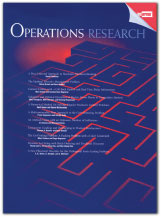Academic articles
Practitioner articles
Working papers
Books
Book chapters
Case studies
Other publications
Subject(s)
Marketing
Keyword(s)
corporate social responsibility, stock risk, marketing-finance interface, advertising, research and development
Marketers and investors face a heated, provocative debate over whether excelling in social responsibility initiatives hurts or benefits firms financially. This study develops a theoretical framework that predicts (1) the impact of corporate social performance (CSP) on firm-idiosyncratic risk and (2) the role of two strategic marketing levers, advertising and research and development (R&D), in explaining the variability of this impact among different firms. The results show that higher CSP lowers undesirable firm-idiosyncratic risk. Notably, although the salutary impact of CSP is greater in firms with higher (versus lower) advertising, a simultaneous pursuit for CSP, advertising, and R&D is harmful with increased firm-idiosyncratic risk. For theory, the authors advance the literature on the marketing-finance interface by drawing attention to the risk-reduction potential of CSP and by shedding new light on some critical but neglected roles of strategic marketing levers. They also extend CSP research by moving away from the long-fought battle for a universal CSP impact and toward a finer-grained understanding of when some firms derive more risk-reduction benefits from CSP. For practice, the results indicate that the "goodwill refundßÂ" of CSP is not unconditional. They also empower marketers to communicate more effectively with investors (i.e., doing good to better manage the risk surrounding firm stock prices).
With the permission of the American Marketing Association
Volume
73
Journal Pages
198–213
Subject(s)
Marketing
Keyword(s)
utility-preference, estimation, theory, prospect theory, loss aversion
The silver lining effect predicts that segregating a small gain from a larger loss results in greater psychological value than does integrating them into a smaller loss. Using a generic prospect theory value function, we formalize this effect and derive conditions under which it should occur. We show analytically that if the gain is smaller than a certain threshold, segregation is optimal. This threshold increases with the size of the loss and decreases with the degree of loss aversion of the decision maker. Our formal analysis results in a set of predictions suggesting that the silver lining effect is more likely to occur when (i) the gain is smaller (for a given loss), (ii) the loss is larger (for a given gain), and (iii) the decision maker is less loss averse. We test and confirm these predictions in two studies of preferences, both in a nonmonetary and a monetary setting, analyzing the data in a hierarchical Bayesian framework.
© 2009 INFORMS
Volume
55
Journal Pages
1832–1841
ISSN (Online)
1526-5501
ISSN (Print)
0025–1909
Subject(s)
Strategy and general management
Keyword(s)
strategic innovation, business model innovation, competitive advantage, competitive strategy
British artist Damien Hirst is both controversial and successful. Jörg Reckhenrich, Jamie Anderson and Martin Kupp suggest that his innovative approach to life and work demonstrate strategies useful to organizations.
© 2009 The Author Journal compilation © 2009 London Business School
Volume
20
Journal Pages
40–47
Subject(s)
Economics, politics and business environment
Keyword(s)
computers, productivity
Volume
41
Journal Pages
1–10
Subject(s)
Technology, R&D management
Keyword(s)
customers, decision making, industrial services, services
Industrial product service systems (IPS²) are required to meet current customer needs in order to provide solutions to current customer problems. Furthermore, adaptability to changing customer decision drivers is required in order to account for customers' preference changes over time. The purpose of this paper is to present an approach where customer preference drivers for different IPS2 are identified and their directions analyzed.
With permission of Emerald
Volume
20
Journal Pages
640–653
Subject(s)
Management sciences, decision sciences and quantitative methods
Keyword(s)
exchangeable continuous data, maximum likelihood, correlation, accept-reject simulation
This article investigates the Farlie-Gumbel-Morgenstern class of models for exchangeable continuous data. We show how the model specification can account for both individual and cluster level covariates, we derive insights from comparisons with the multivariate normal distribution, and we discuss maximum likelihood inference when a sample of independent clusters of varying sizes is available. We propose a method for maximum likelihood estimation which is an alternative to direct numerical maximization of the likelihood that sometimes exhibits non-convergence problems. We describe an algorithm for generating samples from the exchangeable multivariate Farlie-Gumbel-Morgenstern distribution with any marginals, using the structural properties of the distribution. Finally, we present the results of a simulation study designed to assess the properties of the maximum likelihood estimators, and we illustrate the use of the FGM distributions with the analysis of a small data set from a developmental toxicity study.
With permission of Elsevier
Volume
6
Journal Pages
503–512
Subject(s)
Product and operations management
Keyword(s)
capacity allocation, revenue management, dynamic pricing, nonprofit
Nonprofit firms sometimes engage in for-profit activities for the purpose of generating revenue to subsidize their mission activities. The organization is then confronted with a consumption versus investment trade-off, where investment corresponds to providing capacity for revenue customers, and consumption corresponds to serving mission customers. Exemplary of this approach are the Aravind Eye Hospitals in India, where profitable paying hospitals are used to subsidize care at free hospitals. We model this problem as a multiperiod stochastic dynamic program. In each period, the organization must decide how much of the current assets should be invested in revenue-customer service capacity, and at what price the service should be sold. We provide sufficient conditions under which the optimal capacity and pricing decisions are of threshold type. Similar results are derived when the selling price is fixed, but the banking of assets from one period to the next is allowed. We compare the performance of the optimal threshold policy with heuristics that may be more appealing to managers of nonprofit organizations, and we assess the value of banking and of dynamic pricing through numerical experiments.
© 2009 INFORMS
Volume
57
Journal Pages
1114–1128
Subject(s)
Human resources management/organizational behavior
Keyword(s)
help-seeking, sensemaking, role theory, error management, health care
Volume
94
Journal Pages
1261–1274
Subject(s)
Technology, R&D management
Keyword(s)
industrial product service systems; net present value approach; real options approach
Companies from industrialized nations have faced with the threat of competition from low-cost countries. We suggest Industrial Product Service Systems (IPS²) as a possible answer. Our article has two main aims. We establish a framework for designing an initial IPS² which meets current customer and market requirements. Building on this, we broaden our focus to include requirements induced by subsequent changes. We propose a combination of the Net Present Value Approach and the Real Options Approach as a means of determining the quantified value of an IPS² for an individual customer over its life cycle.
With permission of Elsevier
Volume
1
Journal Pages
279–286
Subject(s)
Marketing
Keyword(s)
self-control, goals, temptation
Volume
18
Journal Pages
247–252
ISSN (Online)
1467-8721
ISSN (Print)
0963-7214


